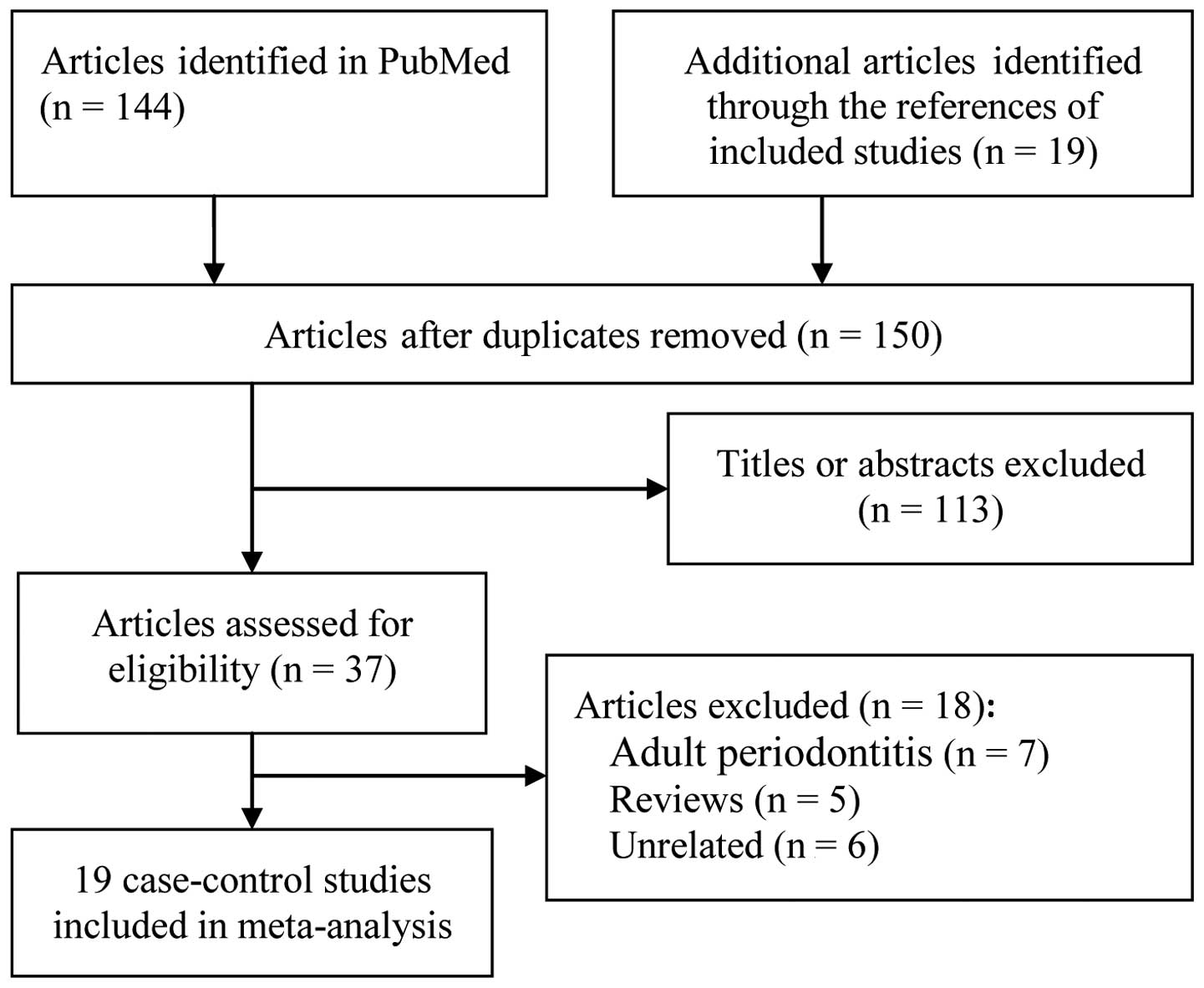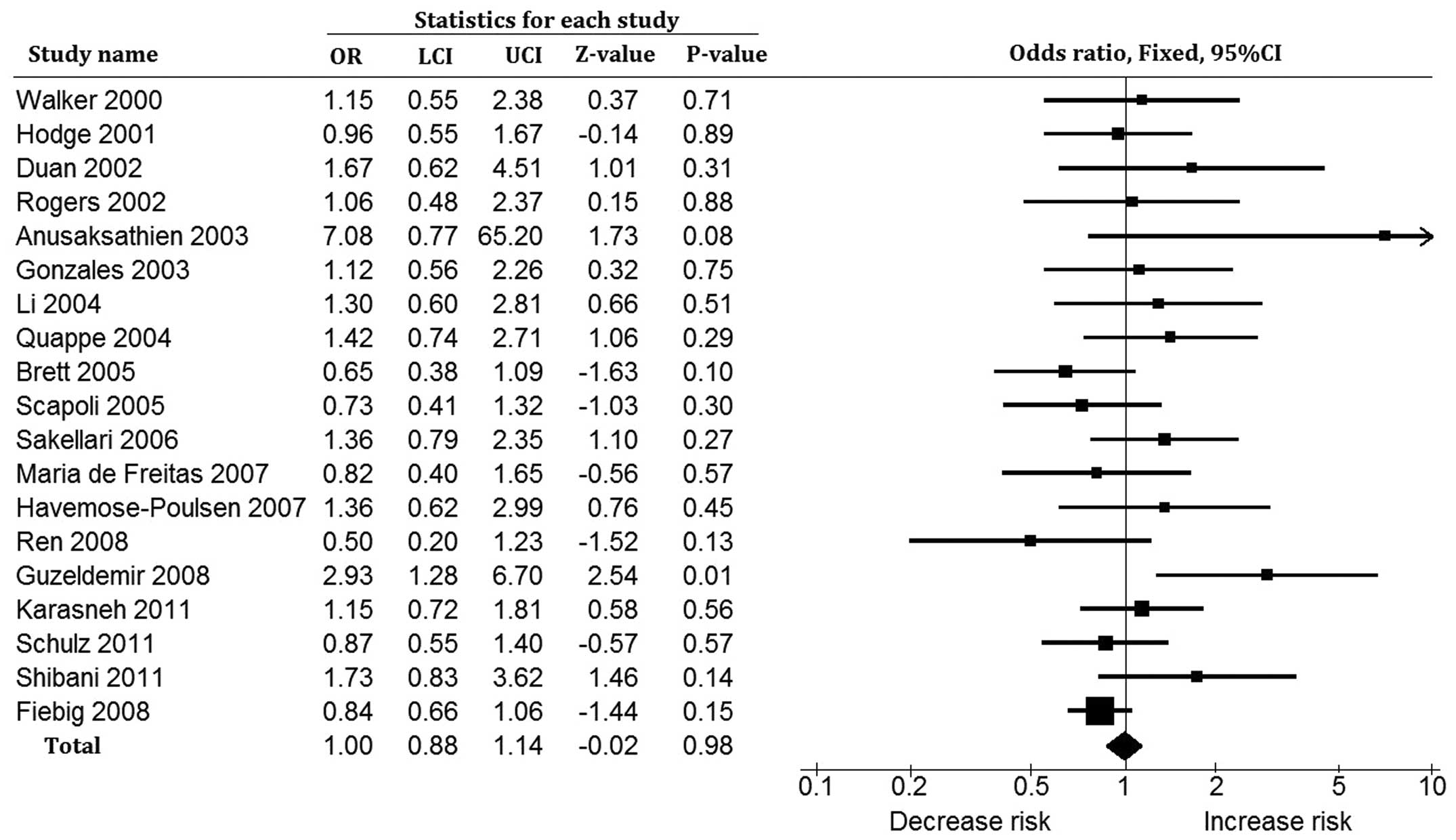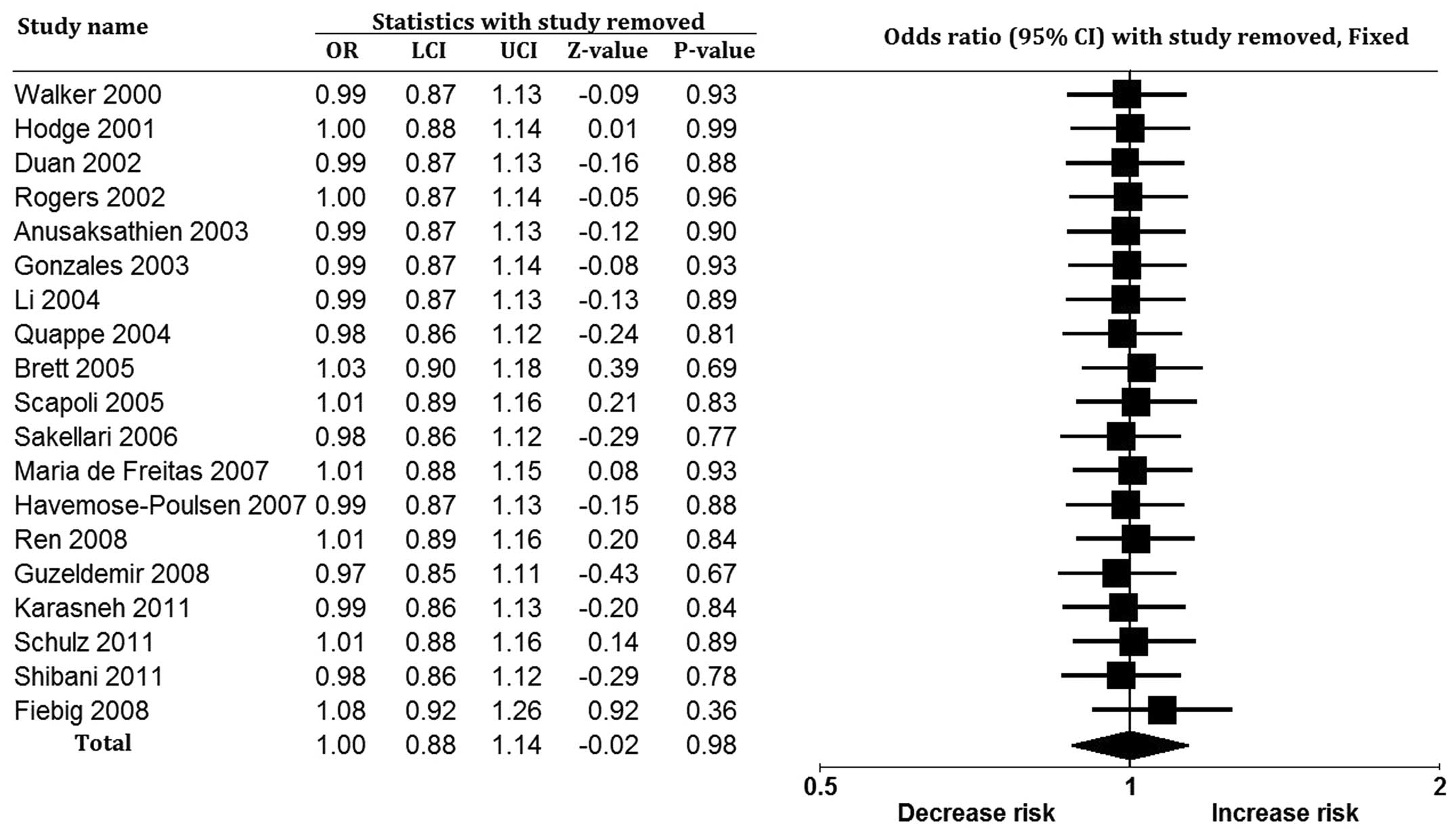Interleukin‑1α ‑899 (+4845) C→T polymorphism is not associated with aggressive periodontitis susceptibility: A meta‑analysis based on 19 case‑control studies
- Authors:
- Published online on: February 19, 2014 https://doi.org/10.3892/br.2014.240
- Pages: 378-383
Abstract
Introduction
Periodontitis is an inflammatory disease of the supporting tissues of the teeth (1) and is considered to be a risk factor for several systemic conditions (2), such as cardiovascular disease (3,4), diabetes (5) and chronic obstructive pulmonary disease (6). Periodontitis is currently classified as two main forms: chronic periodontitis (CP) and aggressive periodontitis (AgP). AgP is less prevalent compared to CP, but is associated with more rapid attachment loss and bone destruction (7). The pathophysiology of this disease may be determined by a variety of microbial, environmental, genetic and behavioural factors and systemic diseases (8). However, for patients with a reasonably good oral hygiene who develop this condition (7), AgP is considered to be a genetically inherited disease (9). Several family-based studies demonstrated that AgP is an autosomal recessive disorder (10–13), indicating a missense mutation of the cathepsin C gene in the 11q14 chromosome as being involved in the development of this disease (14).
Various candidate genes have been investigated for association with AgP and polymorphisms in the interleukin-1α (IL-1α) gene were suggested to affect the transcription of IL-1α, with −899 (+4845) C→T identified as one of the relevant polymorphisms. Walker et al (15) first reported that the IL-1α −899 (+4845) C→T polymorphism was not associated with the risk of AgP in African-American patients. Since then, a number of studies were conducted to investigate the association between this polymorphism and the risk of AgP. However, those studies had two limitations: i) consistent results could not be obtained due to the selection criteria of patients and controls and their ethnic origin; and ii) the majority of those studies included a limited number of patients (≤40). Therefore, the aim of this study was to investigate the association between IL-1α −899 (+4845) C→T polymorphism and the risk of AgP by performing a meta-analysis of previously conducted studies.
Materials and methods
Eligibility criteria
The inclusion criteria were as follows: i) studies that investigated the association between the IL-1α −899 (+4845) C→T polymorphism and susceptibility to AgP; ii) the study design was case-control and the diagnostic criteria of AgP were clearly reported; iii) the AgP patients were free of any other systemic disease and the control subjects were healthy or periodontitis-free; iv) the studies reported the odds ratios (ORs) and associated 95% confidence intervals (CIs) or the number of individual genotypes in the case and control groups, or the data required for their calculation; and v) the publication language was English or Chinese.
This meta-analysis was conducted in concordance with the Meta-analysis Of Observational Studies in Epidemiology (MOOSE) guidelines (16).
Search strategy
The search terms ‘polymorphism’ or ‘mutation’ or ‘variant’, ‘interleukin-1’ or ‘IL-1’ and ‘periodontitis’ or ‘periodontal disease’ were used to conduct a search through PubMed up to May 1, 2013. The reference lists of the included studies and recent reviews were manually searched to identify additional relevant studies.
Data extraction
According to the prespecified selection criteria, two authors independently selected the studies and extracted the following data: surname of first author, year of publication, country of origin and ethnicity, source of controls, number and genotyping distribution of cases and controls, OR and its 95% CI, genotyping method and Hardy-Weinberg equilibrium (HWE) for controls. Any disagreements were resolved by consulting a third author.
Statistical analysis
We calculated the ORs and corresponding 95% CIs for the rare and common alleles. Heterogeneity among included studies was detected using I2 statistics (17). The value of I2≤40% was considered to indicate no significant heterogeneity and the fixed effects model was used; otherwise, the random effects model was used. We also performed subgroup analyses based on ethnicity, source of controls and the HWE for controls. A sensitivity analysis was performed by excluding one study at a time. The publication bias was assessed by funnel plot analysis and the Egger’s linear regression test (18). All the analyses were performed using Comprehensive Meta-Analysis software, version 2 (Biostat, Inc., Englewood, NJ, USA) (19) and the P-values were two-sided.
Results
Study characteristics
The primary search resulted in the identification of 163 publications. Finally, 19 case-control studies, including a total of 1,266 AgP patients and 2,134 healthy controls, were deemed as eligible for inclusion in this meta-analysis (15,20–37). The study selection process is shown in Fig. 1.
Of the 19 studies, 14 investigated probands of Caucasian (20,22,24,26–33,35–37), 4 of Asian (21,23,25,34), and 1 of African-American origin (15). Only 1 study was not in HWE (27) and 1 study reported ORs and 95% CIs for the rare and common alleles (32). The main characteristics of the identified studies are summarized in Table I.
Meta-analysis
Overall, the rare and common alleles provided no evidence supporting an association between the IL-1α −899 (+4845) C→T polymorphism and susceptibility to AgP (OR=1.00, 95% CI: 0.88–1.14, P=0.98 for the T vs. C allele and OR=0.99, 95% CI: 0.85–1.14, P=0.85 for the C vs. T allele; Fig. 2). The subgroup analyses for ethnicity, source of controls and HWE, also revealed no such association. The sensitivity analysis, performed by excluding studies one at a time, reached a similar conclusion (Fig. 3). The results of the meta-analysis are presented in Table II.
Publication bias
A weak publication bias was observed in this meta-analysis (Fig. 4), as evidenced by Egger’s test (P=0.02), also shown in detail in Table II.
Discussion
The early onset form of periodontitis (juvenile, post-juvenile, post-adolescent) is less prevalent, but is associated with more rapid bone destruction at a relatively young age and is therefore termed ‘AgP’ (32). Unlike CP, AgP is likely a genetically inherited disease (9). Numerous studies previously evaluated the association between IL-1α −899 (+4845) C→T polymorphism and AgP, although the reported results are inconsistent (Fig. 2). In addition, the credibility of the results from a single case-control study is questionable due to the relatively limited sample size. Meta-analysis has being widely used in genetic association studies due to its advantage of overcoming this limitation (38–40). The present meta-analysis, based on 19 case-control studies, aimed to provide a comprehensive analysis of the association between IL-1α −899 (+4845) C→T polymorphism and susceptibility to AgP. Our results indicated that there is no such association, either under T vs. C or C vs. T allele comparison. These results are consistent with those of the largest-sample and multicenter study, including a total of 415 AgP patients and 874 healthy controls (32), but not with the results of the smallest-sample and single-center study, which included 31 AgP patients and 31 healthy controls (33). This finding may provide evidence that a meta-analysis has the advantage of overcoming the limitations of a single case-control study by enlarging the sample size.
To further investigate the association between IL-1α −899 (+4845) C→T polymorphism and susceptibility to AgP, subgroup analyses by ethnicity, source of controls and HWE were performed. All the results were consistent with those of the overall analysis, indicating no role for ethnic background or environment. Therefore, AgP is likely a genetically inherited disease (9) and it was concluded from our results that the C or T allele did not affect the risk of AgP.
There were some limitations to our meta-analysis. First, the patient samples of the majority of the included studies were limited (≤40). Although this may be attributed to the low prevalence of AgP, a small sample size is associated with the possibility of bias. Second, despite thorough attempts to collect relevant studies, publication bias also existed. This may result from the language limitation to English and Chinese, or from negative results not being published. Third, due to the lack of data on origin in the included studies, we were unable to assess the gene-environment interactions, which may affect the susceptibility to AgP. Finally, the negative association between IL-1α −899 (+4845) C→T polymorphism and susceptibility to AgP should be interpreted with caution.
In conclusion, our meta-analysis, based on a total of 1,266 AgP patients and 2,134 healthy controls, demonstrated that the IL-1α −899 (+4845) C→T polymorphism is not associated with the risk of AgP. However, due to the abovementioned limitations of the present study, our results may be considered as inconclusive.
Acknowledgements
This study was supported in part by a grant from the Foundation of Education and Science Planning Project of Hubei Province (no. 2012A050) and the Intramural Research Program of the Hubei University of Medicine (no. 2011CZX01), without commercial or not-for-profit sectors. The funders had no role in study design, data collection and analysis, decision to publish, or preparation of the manuscript. No additional external funding was received for this study.
References
|
Pihlstrom BL, Michalowicz BS and Johnson NW: Periodontal diseases. Lancet. 366:1809–1820. 2005. View Article : Google Scholar | |
|
Cullinan MP, Ford PJ and Seymour GJ: Periodontal disease and systemic health: current status. Aust Dent J. 54(Suppl 1): S62–S69. 2009. View Article : Google Scholar : PubMed/NCBI | |
|
Blaizot A, Vergnes JN, Nuwwareh S, Amar J and Sixou M: Periodontal diseases and cardiovascular events: meta-analysis of observational studies. Int Dent J. 59:197–209. 2009.PubMed/NCBI | |
|
Leng WD, Zeng XT, Chen YJ, Zhan ZQ and Yang Y: Periodontal disease is associated with increased coronary heart disease risk: A meta-analysis based on 38 case-control studies. World J Meta-Anal. 1:47–56. 2013. | |
|
Preshaw PM, Alba AL, Herrera D, et al: Periodontitis and diabetes: a two-way relationship. Diabetologia. 55:21–31. 2012. View Article : Google Scholar : PubMed/NCBI | |
|
Zeng XT, Tu ML, Liu DY, Zheng D, Zhang J and Leng W: Periodontal disease and risk of chronic obstructive pulmonary disease: a meta-analysis of observational studies. PLoS One. 7:e465082012. View Article : Google Scholar : PubMed/NCBI | |
|
Sandhu SP, Kakar V, Gogia G and Narula SC: Unilateral gingival fibromatosis with localized aggressive periodontitis (involving first molars): An unusual case report. J Indian Soc Periodontol. 13:109–113. 2009. View Article : Google Scholar : PubMed/NCBI | |
|
Meng H, Xu L, Li Q, Han J and Zhao Y: Determinants of host susceptibility in aggressive periodontitis. Periodontol 2000. 43:133–159. 2007. View Article : Google Scholar : PubMed/NCBI | |
|
Hart TC, Pallos D, Bozzo L, et al: Evidence of genetic heterogeneity for hereditary gingival fibromatosis. J Dent Res. 79:1758–1764. 2000. View Article : Google Scholar : PubMed/NCBI | |
|
Saxen L and Nevanlinna HR: Autosomal recessive inheritance of juvenile periodontitis: test of a hypothesis. Clin Genet. 25:332–335. 1984. View Article : Google Scholar : PubMed/NCBI | |
|
Jorgenson RJ, Levin LS, Hutcherson ST and Salinas CF: Periodontosis in sibs. Oral Surg Oral Med Oral Pathol. 39:396–402. 1975. View Article : Google Scholar : PubMed/NCBI | |
|
Boughman JA, Astemborski JA and Suzuki JB: Phenotypic assessment of early onset periodontitis in sibships. J Clin Periodontol. 19:233–239. 1992. View Article : Google Scholar : PubMed/NCBI | |
|
Long JC, Nance WE, Waring P, Burmeister JA and Ranney RR: Early onset periodontitis: a comparison and evaluation of two proposed modes of inheritance. Genet Epidemiol. 4:13–24. 1987. View Article : Google Scholar : PubMed/NCBI | |
|
Hart TC, Hart PS, Michalec MD, et al: Localisation of a gene for prepubertal periodontitis to chromosome 11q14 and identification of a cathepsin C gene mutation. J Med Genet. 37:95–101. 2000. View Article : Google Scholar : PubMed/NCBI | |
|
Walker SJ, Van Dyke TE, Rich S, Kornman KS, di Giovine FS and Hart TC: Genetic polymorphisms of the IL-1alpha and IL-1beta genes in African-American LJP patients and an African-American control population. J Periodontol. 71:723–728. 2000. View Article : Google Scholar : PubMed/NCBI | |
|
Stroup DF, Berlin JA, Morton SC, et al: Meta-analysis of observational studies in epidemiology: a proposal for reporting. Meta-analysis Of Observational Studies in Epidemiology (MOOSE) group. JAMA. 283:2008–2012. 2000. View Article : Google Scholar : PubMed/NCBI | |
|
Huedo-Medina TB, Sanchez-Meca J, Marin-Martinez F and Botella J: Assessing heterogeneity in meta-analysis: Q statistic or I2index? Psychol Methods. 11:193–206. 2006. View Article : Google Scholar : PubMed/NCBI | |
|
Egger M, Davey Smith G, Schneider M and Minder C: Bias in meta-analysis detected by a simple, graphical test. BMJ. 315:629–634. 1997. View Article : Google Scholar : PubMed/NCBI | |
|
Borenstein M, Hedges L, Higgins J and Rothstein H: Comprehensive Meta-analysis Version 2. Biostat; Englewood, NJ, USA: 2005 | |
|
Hodge PJ, Riggio MP and Kinane DF: Failure to detect an association with IL1 genotypes in European Caucasians with generalised early onset periodontitis. J Clin Periodontol. 28:430–436. 2001. View Article : Google Scholar : PubMed/NCBI | |
|
Duan H, Zhang J and Zhang Y: The association between IL-1 gene polymorphisms and susceptibility to severe periodontitis. West Chin J Stomatol. 20:48–51. 2002.(In Chinese). | |
|
Rogers MA, Figliomeni L, Baluchova K, et al: Do interleukin-1 polymorphisms predict the development of periodontitis or the success of dental implants? J Periodontal Res. 37:37–41. 2002. View Article : Google Scholar : PubMed/NCBI | |
|
Anusaksathien O, Sukboon A, Sitthiphong P and Teanpaisan R: Distribution of interleukin-1beta(+3954) and IL-1alpha(−889) genetic variations in a Thai population group. J Periodontol. 74:1796–1802. 2003. | |
|
Gonzales JR, Michel J, Rodriguez EL, Herrmann JM, Bodeker RH and Meyle J: Comparison of interleukin-1 genotypes in two populations with aggressive periodontitis. Eur J Oral Sci. 111:395–399. 2003. View Article : Google Scholar : PubMed/NCBI | |
|
Li QY, Zhao HS, Meng HX, et al: Association analysis between interleukin-1 family polymorphisms and generalized aggressive periodontitis in a Chinese population. J Periodontol. 75:1627–1635. 2004. View Article : Google Scholar : PubMed/NCBI | |
|
Quappe L, Jara L and Lopez NJ: Association of interleukin-1 polymorphisms with aggressive periodontitis. J Periodontol. 75:1509–1515. 2004. View Article : Google Scholar : PubMed/NCBI | |
|
Brett PM, Zygogianni P, Griffiths GS, et al: Functional gene polymorphisms in aggressive and chronic periodontitis. J Dent Res. 84:1149–1153. 2005. View Article : Google Scholar : PubMed/NCBI | |
|
Scapoli C, Trombelli L, Mamolini E and Collins A: Linkage disequilibrium analysis of case-control data: an application to generalized aggressive periodontitis. Genes Immun. 6:44–52. 2005.PubMed/NCBI | |
|
Sakellari D, Katsares V, Georgiadou M, Kouvatsi A, Arsenakis M and Konstantinidis A: No correlation of five gene polymorphisms with periodontal conditions in a Greek population. J Clin Periodontol. 33:765–770. 2006. View Article : Google Scholar : PubMed/NCBI | |
|
Havemose-Poulsen A, Sorensen LK, Bendtzen K and Holmstrup P: Polymorphisms within the IL-1 gene cluster: effects on cytokine profiles in peripheral blood and whole blood cell cultures of patients with aggressive periodontitis, juvenile idiopathic arthritis, and rheumatoid arthritis. J Periodontol. 78:475–492. 2007. View Article : Google Scholar | |
|
Maria de Freitas N, Imbronito AV, Neves AC, Nunes FD, Pustiglioni FE and Lotufo RF: Analysis of IL-1A(−889) and TNFA(−308) gene polymorphism in Brazilian patients with generalized aggressive periodontitis. Eur Cytokine Netw. 18:142–147. 2007. | |
|
Fiebig A, Jepsen S, Loos BG, et al: Polymorphisms in the interleukin-1 (IL1) gene cluster are not associated with aggressive periodontitis in a large Caucasian population. Genomics. 92:309–315. 2008. View Article : Google Scholar : PubMed/NCBI | |
|
Guzeldemir E, Gunhan M, Ozcelik O and Tastan H: Interleukin-1 and tumor necrosis factor-alpha gene polymorphisms in Turkish patients with localized aggressive periodontitis. J Oral Sci. 50:151–159. 2008. View Article : Google Scholar : PubMed/NCBI | |
|
Ren XY, Xu L and Meng HX: Interleukin-1 family polymorphisms in aggressive periodontitis patients and their relatives. J Peking Univ Health Sci. 40:28–33. 2008.(In Chinese). | |
|
Karasneh JA, Ababneh KT, Taha AH, Al-Abbadi MS and Ollier WE: Investigation of the interleukin-1 gene cluster polymorphisms in Jordanian patients with chronic and aggressive periodontitis. Arch Oral Biol. 56:269–276. 2011. View Article : Google Scholar : PubMed/NCBI | |
|
Schulz S, Stein JM, Altermann W, et al: Single nucleotide polymorphisms in interleukin-1 gene cluster and subgingival colonization with Aggregatibacter actinomycetemcomitans in patients with aggressive periodontitis. Hum Immunol. 72:940–946. 2011. View Article : Google Scholar : PubMed/NCBI | |
|
Shibani K, Shhab R and Khattab R: Analysis of IL-1α(−889) and IL-1B(+3953) gene polymorphism in Syrian patients with aggressive periodontitis: a pilot study. ISRN Dent. 2011:6825642011. | |
|
Geng P, Chen Y, Ou J, Yin X, Sa R and Liang H: The E-cadherin (CDH1) -C160A polymorphism and colorectal cancer susceptibility: A meta-analysis. DNA Cell Biol. 31:1070–1077. 2012. View Article : Google Scholar : PubMed/NCBI | |
|
Leng WD, Zeng XT, Chen YJ, et al: Cytochrome P450 2E1 Rsa I/Pst I polymorphism and risk of esophageal cancer: A meta-analysis of 17 case-control studies. Exp Ther Med. 4:938–948. 2012. | |
|
Tian GX, Zeng XT, Wang XB, Zhang L, Zhang W and Wei WL: Association between the endothelial nitric oxide synthase gene Glu298Asp polymorphism and coronary heart disease: A metaanalysis of 39 case-control studies. Mol Med Rep. 7:1310–1318. 2013.PubMed/NCBI |













